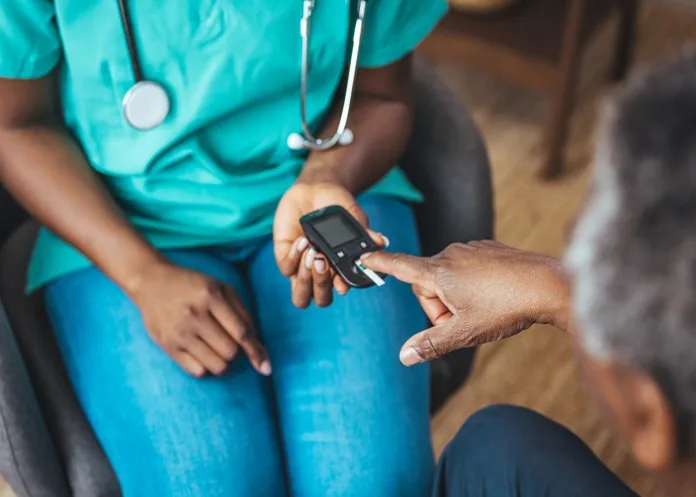Management of diabetes in South Africa – which has seen a notable rise in the prevalence of type 2 diabetes, due to changing diets and the consumption of more processed foods, sugary drinks and high-calorie meals – is not optimal, suggest local experts.
Other factors responsible for the proliferation of the disease are the lack of physical activity and high levels of obesity, write Patrick Ngassa Piotie and Paul Rheeder in The Conversation, with one in nine South African adults having diabetes – around 4.2m people.
It is also the leading cause of death among women in the country.
Piotie and Rheeder write:
As public health specialists and clinicians focusing on diabetes, we researched the standard of primary care received by people with type 2 diabetes in this country, and found that management of the disease falls short of optimal standards, putting people at risk of the many side effects associated with the condition.
What we found, and why it matters
We examined 479 medical records of people diagnosed with type 2 diabetes across 23 primary healthcare facilities in the Tshwane district.
Most of the patients were women. Patients had had diabetes for an average of 5.5 years, and the average age was 58.
When it comes to managing diabetes, there are targets for blood glucose, blood pressure and cholesterol. We used guidelines set out by the Society for Endocrinology, Metabolism and Diabetes South Africa for this study.
Our audit found a significant number of patients with type 2 diabetes were not receiving adequate treatment.
Only 23% of patients met the glucose target, meaning more than 70% of them were at risk of serious health complications.
They attended clinic visits regularly, yet experienced prolonged periods of hyperglycaemia (high blood sugar levels).
We also found that healthcare providers often displayed clinical inertia: they failed to set targets or to initiate or adjust treatment to achieve these goals. They delayed starting or changing a patient’s treatment plan, even when it was clear the current plan wasn’t working well.
Factors contributing to clinical inertia included a uniform treatment approach not suited to all patients, limited treatment options and an inadequately equipped healthcare system.
Given the absence of comprehensive surveillance systems like diabetes registries, studies serve as the primary source of information regarding the implementation and quality of diabetes care in South Africa.
Our results aligned with various studies conducted across South Africa, including one from about a decade ago within the same district.
A more recent study of 116 726 patients in Cape Town found three-quarters of participants had poor glycaemic control as blood sugar levels were not being managed well.
These consistent findings highlight the extra effort needed to overcome clinical inertia to improve diabetes care in South Africa.
High cost of poor treatment
For poorly managed patients, diabetes can lead to severe health complications, like nerve damage, kidney issues, heart disease, stroke, vision impairment and mental health disorders.
For society as a whole, suboptimal diabetes care places a strain on the healthcare system and contributes to higher healthcare costs.
Another consequence is loss of productivity due to absenteeism from work and even disability, which has an economic impact on the country.
Ways forward
Monitoring the quality of diabetes care and evaluating the effectiveness of therapies and treatment in clinical practice is a challenge in South Africa.
New strategies could include:
• adopting individualised patient-centred management with access to a wider choice of glucose-lowering drugs
• addressing clinical inertia and the failure to intensify therapy when indicated
• building a health system that caters for the needs of South African with diabetes.
Inadequate treatment for the many diabetics has devastating consequences, not just for individuals and their families, but for the health system at large.
Patrick Ngassa Piotie, Project Manager, University of Pretoria Diabetes Research Centre.
Paul Rheeder, Project Head, Tshwane Insulin Project, University of Pretoria.
Study details
Suboptimal control and failure to intensify therapy for South Africans with type 2 diabetes: an audit of diabetes management at primary health care facilities
Patrick Ngassa Piotie, Elizabeth Webb & Paul Rheeder.
Published in the Journal of Endocrinology, Metabolism and Diabetes of SA on 15 February 2024
Abstract
Background
The management of people living with type 2 diabetes (T2D) in primary care in a South African district was audited, focusing on glycaemic, cholesterol, and blood pressure (BP) control to identify gaps in care and evidence of clinical inertia.
Methods
A cross-sectional retrospective review was conducted of medical records belonging to patients with T2D seen at 23 primary health care facilities between February and May 2019. Fieldworkers collected patient demographics, BP, laboratory measurements such as HbA1c (two most recent values), total cholesterol (TC) and LDL cholesterol (LDL-C), and which glucose-lowering drug each patient was on, as well as the dosage.
Results
The mean (SD) age of patients was 58 (11.8) years and 64% of them were women. Most patients had hypertension (83%) and were using statins (78%). Most patients (46%) were on second-line therapy and less than a quarter of patients were on insulin (22%). Only 23% (CI: 18.9–27.9%) of patients met the HbA1c target of < 7% with a mean HbA1c of 8.8%. Over half of patients (56%) had achieved the BP target (< 140/90 mmHg) and only 15% (CI: 8.1–23.9%) of the 88 patients with LDL-C values met the LDL target. Healthcare providers failed to intensify oral treatment for most patients who had suboptimal glycaemic control, and most patients who were on maximum oral drugs were not initiated on insulin.
Conclusions
In most patients, diabetes control targets were not met, and treatment was not intensified when needed, suggesting clinical inertia.
See more from MedicalBrief archives:
Concern as diabetes deaths double in past decade
At least 60% of Africa’s diabetes goes undiagnosed – global report
SA Diabetes Alliance calls for urgent education programme
Obese, overweight South Africans costing the country billions of rands
10th edition of IDF Diabetes Atlas: One in nine SA adults living with diabetes

